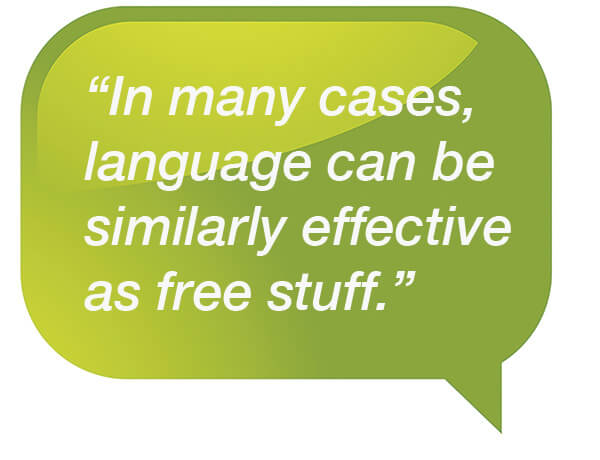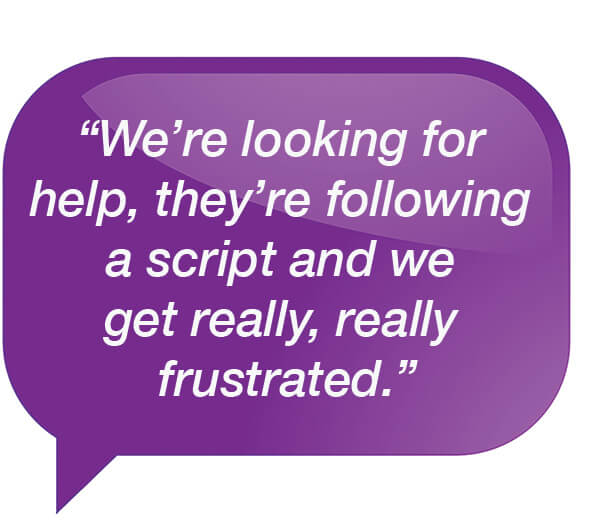Try “I can help you find a firm mattress for your guest room” instead of “I can help you with that” to better serve shoppers
Great customer service is the holy grail of sales. When customers feel satisfied, they spend more money and are more likely to come back. Happy customers write positive reviews online and share their experiences through word-of-mouth. But great customer service can be really hard. Shoppers complain that sales associates aren’t listening to them or are just going through the motions.
There is a simple and cost-effective way to fix that. Jonah Berger, a marketing professor at the Wharton School of the University of Pennsylvania in Philadelphia, has found that when retail sales associates or customer service agents use concrete language, they make customers feel seen, heard and valued. Berger and co-author Grant Packard, a marketing professor at York University’s Schulich School of Business in Toronto, wrote about “How Concrete Language Shapes Customer Satisfaction” in a paper published last year in the Journal of Consumer Research.
Berger talked with Knowledge@Wharton, the school’s online research and business analysis journal. Here’s an edited transcript of the conversation.
Knowledge@Wharton: You and your co-author analyzed more than 1,000 customer service interactions that were either recorded phone calls or written correspondence. What were you looking for?
Jonah Berger: This research actually started with a little bit of a story. A number of years ago, I was on my way to an airport to catch a flight. I got this text message that every traveler dreads: “Your flight has been canceled.” Then two minutes later, I got this note basically saying, “We rebooked you on a flight tomorrow, 15 hours later, with an extra stop along the way.” I really needed to get home, so I called customer service and asked them for help.
We’ve all had an experience like this, whether with an airline or with somebody else, when the interaction just does not go well. We’re looking for help, they’re following a script and we get really, really frustrated. I get off this call and I’m fuming.
My Uber driver says, “You sound like you’re upset.” And I say, “Yes, I just called customer service. I’m pissed. But it’s got to be so difficult to be a customer service agent. You get yelled at all day by people who are upset. It must be a tough job.” He says, “Actually, my daughter is a customer service agent and she was so good they promoted her to help other agents get better.” I sat there and said, “Wow! Beyond giving a free credit or something, how can you make agents better?”
I started to wonder what you might be able to do, besides giving people stuff, to improve customer satisfaction? Grant and I wondered whether the language agents use could make interactions better. Could something as simple as the words agents use make customers more satisfied?

Knowledge@Wharton: Did you find that was the case?
Berger: We found that a certain type of language improves customer satisfaction. It doesn’t just make people happier, it causes them to be more likely to come back and buy more in the future. This linguistic feature is called “concreteness,” basically how concrete the language is that people use.
Sometimes we speak in a more abstract way and sometimes we speak in a more concrete way. We found speaking more concretely, using more concrete language in a variety of customer service or sales interactions, can not only make the customer more satisfied, but also can make them more likely to buy in the future.
Knowledge@Wharton: What is concrete language? Can you give us some examples?
Berger: A sales associate responding to an inquiry about a delivery could say, “It’ll arrive there soon.” Or they could say, “It will arrive at your place” or “It will arrive at your door.” A customer service agent whom you ask for help in a store could say, “Hey, I’ll go look for that” or “I’ll go look for that top” or “I’ll go look for that T-shirt in gray.”
We have a sense of what that T-shirt in gray looks like. When you say “that,” though, it’s harder to get a mental picture. I don’t have a picture in my mind of what “that” is. It’s true even for words like “refund” versus “money.” I have a sense of what money is. Refund is a bit more abstract. In all these cases, the latter versions are more concrete. It’s either a physical object — something people can see, experience, touch — or something they can have a sense of and can imagine in their mind. And that concreteness increases customer satisfaction.
Knowledge@Wharton: So, it’s this idea of precision and exactness. You create a visual in the mind, and that has the effect of making people feel, “This associate is really listening to me. They’re paying attention to my needs.”
Berger: Yes. Obviously, many organizations care about customer service. Trillions of dollars are spent on customer service, so it’s clearly relevant to organizations. Both organizations and individuals want to make people feel like we’ve heard them. Whether we’re trying to sell something or we’re talking to our spouse, people like being listened to. They like feeling like others heard them. How can we communicate that we heard what others are saying? That’s the reason why concrete language is more beneficial.
A good way to think about it is the following: If you’re a customer service agent, it’s really easy to say, “I’ll help you with that.” Every time someone calls, whether they need help with a flight like I did or whether they’re calling about needing a T-shirt or pants (or mattresses), “I’ll help you with that” is sort of the Swiss Army knife of answers. It works with everything. In that sense, it’s really easy from a customer service side.
From the customer’s standpoint, though, if you say, “I can help you with that,” it feels a little bit boilerplate. It’s not clear that you actually heard or listened to what they said. Feeling like someone listened to you is about three things. First, paying attention. Second, understanding. But third, it’s about really showing someone you heard them. And that’s what concrete language does. When I don’t just say, “I’ll help you with that,” but, “Sure, I’ll help you get your flight rebooked from Denver to Philadelphia,” it shows you that I heard what you said, that I was listening, that I paid attention and that I’m more likely to be able to help you in the future. Concreteness works because it makes people feel like you’re listening. Feeling like you’re listening can have a host of other benefits beyond just customer satisfaction.
Knowledge@Wharton: Some of the examples in your paper made me think about the customer service at my favorite restaurant. The wait staff will come to you at the end of the meal and instead of saying, “Can I get you anything else?” or “Are you ready for the check?” they’ll say, “Would you like to try our coffee? It’s really good, and we have these great desserts.”
Berger: Yes, and even take that a step further. When I say something like, “You’ll love our mouth-watering apple pie or our decadent triple-
chocolate cake with molten lava chocolate oozing out the side,” you can see it in your head. You have a very concrete sense of what I’m talking about. Dessert is less abstract and more concrete than, “Can I get you anything else?” But that mouth-watering chocolate cake is even more concrete. By helping people see what you’re saying, it can make them more likely to purchase things.

Knowledge@Wharton: Companies already spend a lot of money on training and recruiting customer-service employees. What can they take from your research to make that training more effective?
Berger: What I love about this work is that it is so easy to apply. As we talked about, things like “this,” “that” and “it” are very broad but not very specific. Use more specific language. Rather than, “I can help you with that,” I should specify the thing I want to help you with. This can happen through adjectives, pronouns and nouns, but also adverbs and verbs. We talked about whether the pie is “really good” or “mouth-wateringly good.” Rather than, “We can get that for you,” we can “grab that (pillow) for you.” Rather than, “I can solve this task,” say, “I can fix that engine issue that you might have.” It can be repeating back what they said, but it can be even more specific in showing that you heard and you’re ready to help.
Knowledge@Wharton: One of the things you point out is that doing this is free. It doesn’t add to the cost of existing training programs.
Berger: This is one thing that is so powerful about language. As a customer, I used to think that the only thing companies could do to make me happy was to give me something of value. But on the company’s side, that can be pretty expensive. If every time there’s a flight cancellation, you’re giving away money or other sorts of things, that’s going to make customers happy, but that may be expensive.
Our research finds that, in many cases, language can be similarly effective as free stuff — not always, and it depends on what you’re giving away. Obviously, the bigger the thing you’re giving away, the happier people will be. But language can be an opportunity to make them equally satisfied. And, in cases, where it’s a sales interaction, where you’re not giving something away, language is a great way to make those things go more effectively.
Knowledge@Wharton: There has been exponential growth in online shopping, especially in the past 18 months, and online customers are going by the descriptions of the products. Should companies be using more concrete language in how they write these descriptions?
Berger: Certainly. We’ve applied this idea of concrete language in a variety of domains. Whether we’re talking about online sales interactions and product descriptions or whether we’re talking about written content online, people are more likely to continue reading because they can understand what’s going on. Even on the “help” page of a website, more concrete language makes you feel like the page is more helpful because it makes it easier to understand. Concrete language can be a great and relatively easy way to improve customer behavior or consumer behavior on a variety of dimensions.
Knowledge@Wharton: Your research often focuses on the psychological and semantic components of marketing. What else are you working on?
Berger: We’re doing some other work with customer service calls, looking at what’s called paralanguage or pausing. If we’re talking and I pause for a second, you tend to say, “Uh-huh,” because it’s a natural thing to do. You tend to agree with someone when they’re speaking. It’s the polite thing to do. What we find is that the more the customer service agent pauses in these interactions, the more they give customers an opportunity to assent, to agree, to say, “Uh-huh, yeah, uh-huh.” A lot of research shows that assenting improves liking and interactions, so we find higher customer satisfaction.
Whether it’s the concrete language we’re using, paralanguage or other linguistic features, there are lots of interesting things we can extract to improve those interactions.
Republished with permission from Knowledge@ Wharton, the online research and business analysis journal of the Wharton School of the University of Pennsylvania based in Philadelphia.

